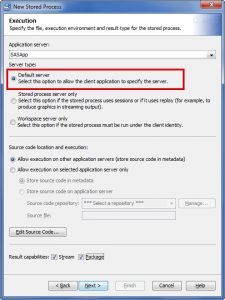 New in 9.3, stored processes can be assigned to run on the 'Default Server' server type. Developers can still force the stored process to run on only one server type but choosing the 'Default Server' allows the client application to specifically call the best server type to run on. Another cool enhancement is the Workspace server now supports streaming output. This reduces the need to duplicate similar processes to run on both the Stored Process server and Workspace server.
New in 9.3, stored processes can be assigned to run on the 'Default Server' server type. Developers can still force the stored process to run on only one server type but choosing the 'Default Server' allows the client application to specifically call the best server type to run on. Another cool enhancement is the Workspace server now supports streaming output. This reduces the need to duplicate similar processes to run on both the Stored Process server and Workspace server.
q: What does this mean?
Both of these changes provide developers with an easier time of managing stored process reports that are needed in multiple devices. For instance, in prior versions the web browser could only directly run stored processes registered on the stored process server since that was the only type supporting streaming output. Now, developers can create one metadata registration to run on both server types.
q: So why would you select a specific server type?
An example of choosing a specific server instead of going with the Default server option is when the stored process includes graphic replay or uses sessions. Both of these require the use of the stored process server.
For more information on what capabilities these two server types provide, review the SAS Documentation.

1 Comment
Hi Angela,
I was pleased to see these enhancements in SAS 9.3. I'd been wondering for a few years why a stored process running on a workspace server didn't support streaming output, so it is great to see it's now supported.
Another reason for selecting a specific server, a workspace server in this case, is to ensure it runs as the requesting user's identity at the operating system level, when a shared identity as used for a stored process server would not be appropriate. This might be required when accessing sensitive data sources, like HR salary data perhaps, where multiple layers of authorization have been implemented for comprehensive security: SAS metadata access controls in addition to file system access controls.
Thanks for another great post. I'm looking forward to reading your BI book when its available.
Paul